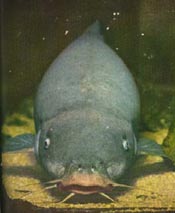| Stonefishes
The most deadly of all fish venoms comes from the stonefish.
Its venom glands are near the bottom of the needle-like
spines on its dorsal fin. The stonefish got its name because
it looks so much like a rock. It spends most of its time
on the ocean floor, half buried in sand. If you accidentally
step on a stonefish, the pressure of your foot will cause
the venom glands to eject poison along the spines and into
your foot. When this happened to a swimmer in South Africa,
the swimmer lived for only about two hours after the accident.
Like turkeyfishes, stonefishes live in the Indo-Pacific
Region (but unlike the lionfish, there are no stonefishes
in Hawaii). In Australia and other areas of the Indo-Pacific,
you can get an antivenin (a serum containing an antitoxin
that will fight the poison) for the stonefish venom.
Catfishes
There are a lot of different species of catfishes.
Some have long narrow bodies that look like eels, while
most are more "fishlike" in appearance. Most catfishes have
barbels or feelers (they sort of look like whiskers) on
each side of their upper jaw and sometimes on their lower
jaw. Many of them have spines on their dorsal (top) and
pectoral (lower side) fins, and some of them are venomous.
One species is the elecric catfish, which lives in tropical
central Africa and the Nile valley. It is able to discharge
as much as 100 volts at one time. An electric catfish can
grow to as much as 4 feet long and weigh fifty pounds. Ancient
Egyptians included pictures of this special fish on their
tombs.
|

Stonefish
photo by Carl Roessler,
A Medical Guide to Hazardous Marine Life,
p. 18

Electric Catfish
photo by John Tashjian,
Living Fishes of the World, p. 43
|
| What You Should Do
The best thing to do is learn to recognize these fishes
and stay away from them. Be careful where you step when
you are swimming, snorkeling or diving. Early morning and
dusk are times when predators (creatures that eat other
creatures) do most of their hunting for food, so be especially
aware during these times. If you or someone with you is
poisoned by one of these venomous fishes, you should get
expert medical help as soon as possible. This is especially
important if you are poisoned by a stonefish, since you
will need the antivenin right away. In the meantime:
1. Cover the wound with water that is as hot as you can
tolerate, but not so hot that it will burn your skin.
This will ease the pain. It will usually take between 30
to 90 minutes for the pain to get better.
2. Remove any pieces of the spine or sheath that you see.
Scrub the wound with soap and water; then pour lots of fresh
water (not ocean water) over it.
3. Do not tape the wound closed.
4. If the injury is infected or if the puncture wound
is deep, you will need to take antibiotics (medicine that
kills germs), for about 7 to 10 days. Some antibiotics make
your skin sensitive to the sun, so you may need to stay
inside during that time.
|

